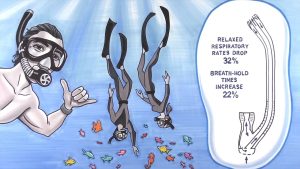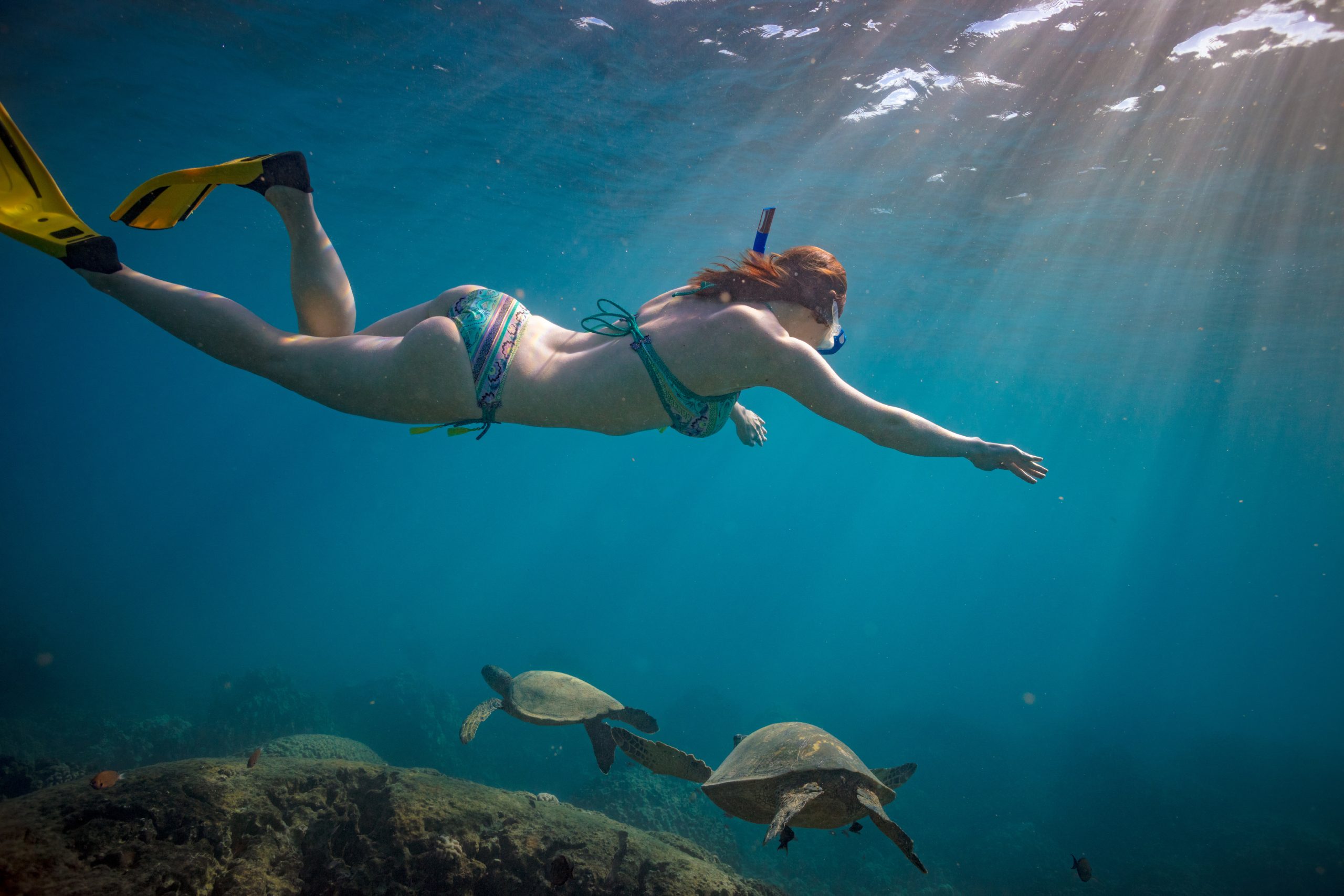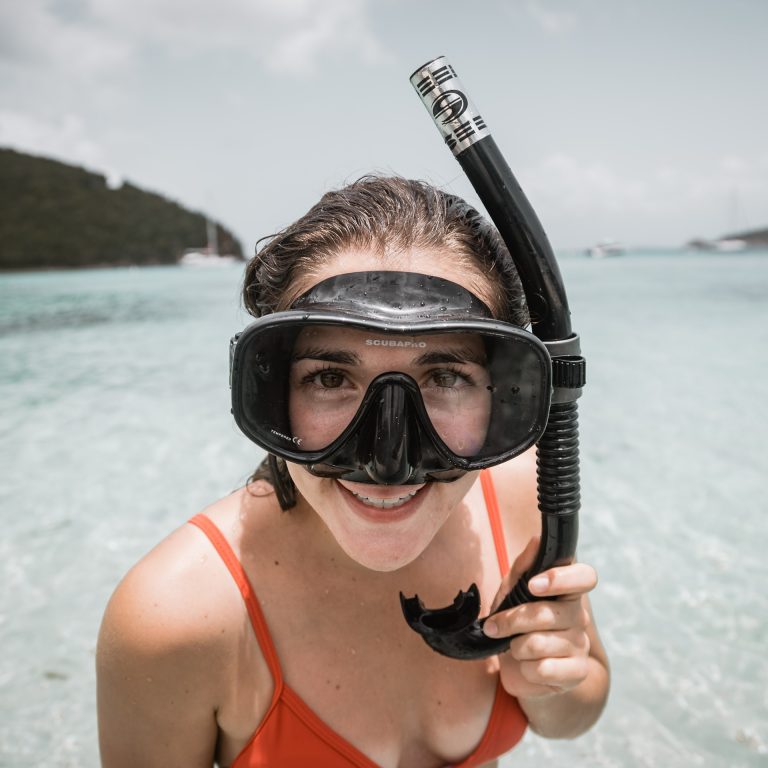Are you planning on breaking the world record for the most extended snorkeling session? Or maybe you’re just curious how long you can stay underwater while snorkeling and enjoying the beautiful underwater world.
Either way, you’re in luck! While there is no set amount of time that you can stay underwater while snorkeling (sorry to disappoint any aspiring mermaids or mermen out there), there are a few things to consider when determining your underwater endurance.
Physical condition, level of activity, and breath-holding ability all play a role in how long you can stay underwater while snorkeling. Remember, listening to your body and surface if you feel uncomfortable or dizzy is always essential. And, of course, try not to panic and swim to the surface like a dolphin on steroids.
How long you can stay underwater while snorkeling?

The main question here is how long you can stay underwater while snorkeling. You may enjoy the marine scenery without time limitations if you snorkel around the surface with your face down. When diving more profoundly, the average human can hold their breath underwater for 45 seconds to 1 minute. This time can be extended using the breathing exercises indicated below.
However, there are approaches for increasing lung capacity and breathing techniques that can lower the pulse rate and slightly lessen the body’s requirement for oxygen.
Different types of snorkeling equipment might also help you enjoy your dive more. Free diving is defined as diving more profound than the surface depth while snorkeling.
Can You Breathe Underwater with a Snorkel?

Yes, a snorkel is a device that allows you to breathe underwater while you are swimming or floating on the surface. It consists of a tube that extends from your mouth to the surface of the water, allowing you to breathe in air from above the water.
This can be especially useful for activities such as snorkeling, where you want to stay underwater for extended periods without having to come up for air.
However, it is essential to note that a snorkel is not a substitute for scuba diving equipment, and it is not safe to use a snorkel for extended periods at depths more significant than a few feet.
When snorkeling, only half submerge the face so the snorkel can readily reach the surface. Beginners frequently make the mistake of tilting their heads down too far, or they are tempted to dive below and forget to submerge the snorkel.
Breathing Underwater with a Dry Snorkel
Many snorkels are now built to be dry snorkels, which means they include a mechanism that prevents water from leaking into the tube and lowers the possibility of breathing a mouthful of water.
A dry snorkel is a type of snorkel that is designed to prevent water from entering the tube when you are underwater. It typically has a splash guard at the top of the tube to deflect water from the opening and a valve at the bottom that seals off the tube when diving underwater. This allows you to breathe in air from the surface while submerging without worrying about water getting into the snorkel.
Breathing Underwater with a Dry Snorkel? Using a dry snorkel is generally more straightforward and more comfortable than a traditional one because you don’t have to constantly clear the water out of the tube. However, it is essential to note that even a dry snorkel is not a substitute for scuba diving equipment, and it is not safe to use a snorkel for extended periods at depths more significant than a few feet.
Important Note
The dry snorkel can occasionally fail and remain sealed after surfacing. Individuals will attempt to exhale a breath only to discover that they cannot do so. If this happens, give the snorkel a shake to release the buoyant ball that keeps the seal up. If you can’t breathe via your dry snorkel, it implies the seal has closed, and you need to surface.
Breathing Underwater with a Traditional Snorkel (J-Snorkel)
Compared to a conventional dry snorkel, the J-snorkel is becoming increasingly primitive as snorkel design improves. J snorkels provide none of the benefits a dry snorkel offers, as the tube includes a large opening through which water may flow.
A traditional snorkel, also known as a J-snorkel, is a simple device that consists of a tube that extends from your mouth to the surface of the water, allowing you to breathe in air from above the water while you are submerged.
Even if you’re an experienced snorkeler, a stray wave might fill your tube and force you to choke. J-type snorkels also lack purge valves, so if you’re not choking uncontrollably, you’ll have to blow extremely hard on the snorkel to send the water back out the way it came. Stick to dry snorkels if you want a pleasant snorkeling experience where you can breathe normally.
To use a traditional snorkel, you place the mouthpiece in your mouth and breathe in and out through the tube. If water enters the tube, you must clear it out before you can continue breathing through the snorkel. This can be done by forcefully exhaling through the snorkel to blow the water out or by holding the top above the water and shaking it to remove the water.
It is important to note that a traditional snorkel is not a substitute for scuba diving equipment, and it is not safe to use a snorkel for extended periods at depths greater than a few feet. It is also important to use a traditional snorkel safely and responsibly, following all relevant safety guidelines and taking appropriate precautions.
Breathing Underwater with a Full Face Snorkel Mask

A new style of snorkel design that incorporates both the snorkel and the mask into one piece, described as a full-face snorkel mask, has emerged in recent years. Full-face snorkel masks completely conceal your face. They don’t have a mouthpiece to bite on, so you won’t have jaw fatigue.
Furthermore, because the oxygen is in the same position, you can breathe through your nose or mouth, while with a snorkel, you can only breathe through your mouth.
Furthermore, full-face snorkel masks have a dry snorkel construction that seals shut when submerged, preventing water from overflowing the tube. If water does manage to get through, full face masks contain a drainage mechanism that expels it, so your face stays dry.
Full-face snorkel masks are ideal for novices who do not want to purchase a mask and snorkel separately. Look for a full-face snorkel mask to allow you to breathe freely underwater when snorkeling.
Factors Affecting A Snorkelers Time Underwater
While ‘as long as you can hold your breath’ is the very simple answer to the question of how long a snorkeler can remain underwater, the fact is that there are a variety of factors that affect time beneath the waves.
Several factors can affect the amount of time a snorkeler can spend underwater:
- Breath-holding ability: The longer you can hold your breath, the longer you will be able to stay underwater. Some people can naturally hold their breath for longer than others, but their breath-holding ability can also be improved with practice.
- Fitness level: Being in good physical shape can help you stay underwater longer because your body will be better able to withstand the physical demands of snorkeling.
- Depth: The deeper you are underwater, the more air you will need to consume, and the shorter your dive will be.
- Activity level: The more active you are underwater, the more air you will consume and the shorter your dive will be.
- Temperature: Cold water can make it harder to hold your breath because it causes your body to use more oxygen.
- Equipment: Using a dry snorkel or other specialized equipment can help you stay underwater longer because it reduces the amount of water entering the tube and makes breathing easier.
- Snorkeling technique: You will automatically begin to ‘be at one with the water’ as you get more experience. Your approach will grow more balanced, your motions will become less violent, and the effort required to complete a job will be reduced.
To maximize your time underwater, it is important to be in good physical shape, use the appropriate equipment, and take appropriate safety precautions. Practicing holding your breath and building up your breath-holding ability is also a good idea.
How To Maximize Your Time Underwater
Most snorkelers like swimming as far as they can along the bottom of the sea. Why should they not? That is wonderful.
Improving your respiratory fitness is the greatest method to optimize your time underwater among the fish. Because most snorkeling is done at shallow depths, the most excellent approach to improve your capacity to stay underwater longer is to practice holding your breath.
Here is a step-by-step guide to maximizing your time underwater while snorkeling:
Practice holding your breath: To improve your breath-holding ability, try the following exercises:
- Take deep breaths and exhale entirely before holding your breath.
- Practice holding your breath for extended periods on land, gradually increasing the duration.
- Try exhaling through your nose while holding your breath to reduce the urge to breathe.
- Practice holding your breath in the water, starting with short dives and gradually increasing the duration.
Use a dry snorkel or other specialized equipment: A dry snorkel can help you stay underwater longer because it prevents water from entering the tube. Other specialized equipment, such as a full-face snorkel mask, can make breathing easier and help you stay underwater for extended periods.
Stay at shallower depths: The deeper you are underwater, the more air you need to consume, and the shorter your dive will be. Staying at shallower depths will allow you to stay underwater longer.
Limit your activity level: The more active you are underwater, the more air you consume, and the shorter your dive will be. Limiting your activity level and moving slowly and efficiently can help you stay underwater longer.
Use the appropriate equipment: The appropriate equipment, such as a wetsuit or a weight belt, can help you stay underwater longer by making it easier to maintain your buoyancy and conserve energy. Taking breaks to rest and catch your breath can help you stay underwater longer because it gives your body a chance to recover and replenish its oxygen stores.
Follow all safety guidelines: It is essential to follow all relevant safety guidelines and take appropriate precautions to ensure that you have a safe and enjoyable snorkeling experience. This includes wearing the appropriate safety gear, such as a personal flotation device and staying within your limits and comfort level.
Conclusion:
I think you have all the knowledge about how long you can stay underwater while snorkeling. Snorkeling is a fun and exciting way to explore the underwater world, and with the proper techniques and equipment, you can stay underwater for extended periods.
To maximize your time underwater, it is important to practice holding your breath and building up your breath-holding ability, use a dry snorkel or other specialized equipment, stay at shallower depths, limit your activity level, use the appropriate equipment, take breaks, and follow all relevant safety guidelines.
By following these tips, you can have a safe and enjoyable snorkeling experience and stay underwater for as long as you desire.







